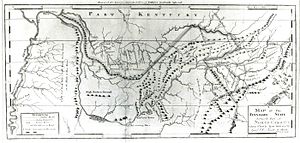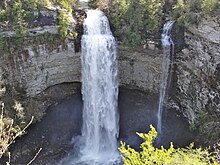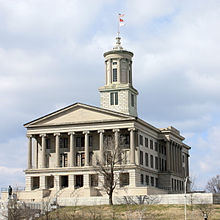Tennesseetv.com
Tennessee (/ˌtɛnəˈsiː/ (![]() listen),[7][8] locally /ˈtɛnɪsi/[9]), officially the State of Tennessee, is a state in the Southeastern region of the United States. Tennessee is the 36th largest by area and the 16th most populous of the 50 states. It is bordered by Kentucky to the north, Virginia to the northeast, North Carolina to the east, Georgia, Alabama, and Mississippi to the south, Arkansas to the southwest, and Missouri to the northwest. Tennessee is geographically, culturally, and legally divided into three Grand Divisions of East, Middle, and West Tennessee. Nashville is the state’s capital and largest city, and anchors its largest metropolitan area. Tennessee’s population as of the 2020 United States census is approximately 6.9 million.[10]
listen),[7][8] locally /ˈtɛnɪsi/[9]), officially the State of Tennessee, is a state in the Southeastern region of the United States. Tennessee is the 36th largest by area and the 16th most populous of the 50 states. It is bordered by Kentucky to the north, Virginia to the northeast, North Carolina to the east, Georgia, Alabama, and Mississippi to the south, Arkansas to the southwest, and Missouri to the northwest. Tennessee is geographically, culturally, and legally divided into three Grand Divisions of East, Middle, and West Tennessee. Nashville is the state’s capital and largest city, and anchors its largest metropolitan area. Tennessee’s population as of the 2020 United States census is approximately 6.9 million.[10]
Tennessee is rooted in the Watauga Association, a 1772 frontier pact generally regarded as the first constitutional government west of the Appalachian Mountains.[11] Its name is derived from “Tanasi“, a Cherokee town in the eastern part of the state that existed before the first European American settlement.[12] Tennessee was initially part of North Carolina, and later the Southwest Territory, before its admission to the Union as the 16th state on June 1, 1796. It earned the nickname “The Volunteer State” early in its history due to a strong tradition of military service.[13] A slave state until the American Civil War, Tennessee was politically divided, with its western and middle parts supporting the Confederacy and the eastern region harboring pro–Union sentiment. As a result, Tennessee was the last state to formally join the Confederacy and the first readmitted to the Union after the war.[14]
During the 20th century, Tennessee transitioned from a predominantly agrarian society to a more diversified economy. This was aided in part by massive federal investment in the Tennessee Valley Authority (TVA) and the city of Oak Ridge, which was established during World War II to house the Manhattan Project‘s uranium enrichment facilities for the construction of the world’s first atomic bombs. These were dropped on Imperial Japan at the end of the war. After the war, the Oak Ridge National Laboratory became a key center of scientific research. In 2016, the element tennessine was named for the state, largely in recognition of the roles played by Oak Ridge, Vanderbilt University, and the University of Tennessee in its discovery.[15] The state has also played a major role in the development of many forms of popular music, including country, blues, rock and roll, soul, and gospel.
Tennessee has diverse terrain and landforms, and from east to west, contains a mix of cultural features characteristic of Appalachia, the Upland South, and the Deep South. The Blue Ridge Mountains along the eastern border reach some of the highest elevations in eastern North America, and the Cumberland Plateau contains many scenic valleys and waterfalls. The central part of the state is marked by cavernous bedrock and irregular rolling hills, and level, fertile plains define West Tennessee. The state is twice bisected by the Tennessee River, and the Mississippi River forms its western border. Its economy is dominated by the health care, music, automotive, chemical, electronics, banking, food, and tourism industries, and cattle, soybeans, corn, poultry, and cotton are its primary agricultural products.[16] The Great Smoky Mountains National Park, the nation’s most visited national park, is in eastern Tennessee.[17]
Etymology
The name Tennessee derives from the Cherokee settlement of Tanasi (ᏔᎾᏏ), whose etymology is uncertain.[18] According to ethnographer James Mooney, the name “can not be analyzed”, and its meaning is lost.[19] The modern spelling is attributed to James Glen, the governor of South Carolina, who used it in his official correspondence during the 1750s. The spelling was popularized by the publication of Henry Timberlake‘s Draught of the Cherokee Country in 1765. In 1788, North Carolina created “Tennessee County“, the third county to be established in what is now Middle Tennessee. When a constitutional convention met in 1796 to organize a new state out of the Southwest Territory, it adopted “Tennessee” as the name of the state.[20]
History
Pre-European era
The first inhabitants of Tennessee were Paleo-Indians who arrived about 12,000 years ago at the end of the Last Glacial Period. Archaeological excavations have indicated that the lower Tennessee Valley was heavily populated with Ice Age hunter-gatherers, and Middle Tennessee is believed to have been rich with game animals such as mastodons.[21] The names of the cultural groups who inhabited the area before European contact are unknown, but archaeologists have named several distinct cultural phases, including the Archaic (8000–1000 BC), Woodland (1000 BC–1000 AD), and Mississippian (1000–1600 AD) periods.[22] The Archaic peoples first domesticated dogs, and plants such as squash, corn, gourds, and sunflowers were first grown in Tennessee during the Woodland period.[23] Later generations of Woodland peoples constructed the first mounds in the state. Rapid civilizational development occurred during the Mississippian period, when Indigenous peoples developed organized chiefdoms and constructed numerous ceremonial structures throughout the state.[24]
Spanish conquistadors who explored the state in the 16th century encountered some of the Mississippian peoples, including the Muscogee Creek, Yuchi, and Shawnee.[25][26] By the early 18th century, most Natives in Tennessee had disappeared, most likely wiped out by diseases introduced by the Spaniards.[25] The Cherokee began migrating into what is now eastern Tennessee from what is now Virginia in the latter 17th century, possibly to escape expanding European settlement and diseases in the north.[27] They forced the Creek, Yuchi, and Shawnee out of the state in the early 18th century.[27][28] The Chickasaw remained confined to West Tennessee, and the middle part of the state contained few Native Americans, although both the Cherokee and the Shawnee claimed the region as their hunting ground.[29] Cherokee peoples in Tennessee were known by European settlers as the Overhill Cherokee because they lived west of the Blue Ridge Mountains.[30] Overhill settlements grew along the rivers in East Tennessee in the early 18th century.[31]
Exploration and colonization
The first recorded European expeditions into what is now Tennessee were led by Spanish explorers Hernando de Soto in 1540–1541, Tristan de Luna in 1559, and Juan Pardo in 1566–1567.[32][33][34] Pardo recorded the name “Tanasqui” from a local Native American village, which evolved into the state’s current name.[35] In 1673, British fur trader Abraham Wood, sent an expedition led by James Needham and Gabriel Arthur from Fort Henry in the Colony of Virginia into Overhill Cherokee territory in modern-day northeastern Tennessee.[36] Needham was killed during the expedition and Arthur was taken prisoner for more than a year.[37][38] That same year, a French expedition led by missionary Jacques Marquette and trader Louis Jolliet explored the Mississippi River and became the first Europeans to map the Mississippi Valley.[37][36] In 1682, an expedition led by René-Robert Cavelier, Sieur de La Salle constructed Fort Prudhomme on the Chickasaw Bluffs in West Tennessee.[39] By the late 17th century, French traders also began to explore the Cumberland River valley.[40] A group of French traders under Charles Charleville’s command established a fur trading settlement at the present location of downtown Nashville near the Cumberland River in 1714, which became known as French Lick.[40][41] In 1739, the French constructed Fort Assumption under Jean-Baptiste Le Moyne de Bienville on the Mississippi River at the present-day location of Memphis, which they used as a base against the Chickasaw during the 1739 Campaign of the Chickasaw Wars.[42]
In the 1750s and 1760s, longhunters from Virginia explored much of East and Middle Tennessee.[43] In 1756, settlers from the Colony of South Carolina built Fort Loudoun near present-day Vonore, the first British settlement in what is now Tennessee, and the westernmost British outpost to that date.[44][45] Hostilities erupted between the British and the Overhill Cherokees into an armed conflict, and a siege of the fort ended with its surrender in 1760.[46] After the end of the French and Indian War, Britain issued the Royal Proclamation of 1763, which forbade settlements west of the Appalachian Mountains in an effort to mitigate conflicts with the Natives.[47] Migration across the mountains continued, however, and the first permanent European settlers, began arriving in the northeastern part of Tennessee in the late 1760s.[48][49] Most of these settlers were English, but nearly 20% of them were Scotch-Irish.[50] These settlers formed the Watauga Association in 1772, a semi-autonomous representative government.[51] Three years later, the settlers reorganized themselves into the Washington District to support the cause of the American Revolutionary War.[52] The following year, after an unsuccessful petition to Virginia, the settlers petitioned North Carolina to annex the Washington District in order to provide protection from Native American attacks, which was granted in November 1776.[53]
In 1775, Richard Henderson negotiated a series of treaties with the Cherokee to sell the lands of the Watauga settlements at Sycamore Shoals on the banks of the Watauga River in present-day Elizabethton. An agreement to sell land for the Transylvania Colony, which included the territory in modern-day Tennessee north of the Cumberland River, was also signed.[54] Later that year, Daniel Boone, under Henderson’s employment, blazed a trail from Fort Chiswell in Virginia through the Cumberland Gap, which became part of the Wilderness Road, a major thoroughfare for settlers into Tennessee and Kentucky.[55] The Chickamauga, a Cherokee faction loyal to the British led by Dragging Canoe, opposed the settling of the Washington District and Transylvania Colony, and in 1776 attacked Fort Watauga at Sycamore Shoals.[56][57] The warnings of Dragging Canoe’s cousin Nancy Ward spared many settlers’ lives from the initial attacks.[58] The frontier fort served as a staging area for the Overmountain Men in preparation for their trek over the Appalachian Mountains to engage and defeat the British Army at the Battle of Kings Mountain in South Carolina in 1780.[59]
In 1779, James Robertson and John Donelson led two groups of settlers from the Washington District to the French Lick.[60] These settlers constructed Fort Nashborough, which they named for Francis Nash, a brigadier general of the Continental Army.[61] The next year, the settlers signed the Cumberland Compact, which established a representative government known as the Cumberland Association for the colony.[62] This settlement later grew into the city of Nashville.[63]
Three counties of the Washington District broke off from North Carolina in 1784 and formed the State of Franklin.[64] Efforts to obtain admission to the Union failed, and the counties, now numbering eight, rejoined North Carolina by 1788.[65] North Carolina ceded the area to the federal government in 1790, after which it was organized into the Southwest Territory on May 26 of that year.[66] The act allowed for the territory to petition for statehood once the population reached 60,000.[66] Administration of the territory was divided between the Washington District and the Mero District, the latter of which consisted of the Cumberland Association and was named for Spanish territorial governor Esteban Rodríguez Miró.[67] President George Washington appointed William Blount as territorial governor.[68] The Southwest Territory recorded a population of 35,691 in the first United States census that year, including 3,417 slaves.[69]
Statehood and antebellum era
As support for statehood grew among the settlers, Governor Blount called for elections, which were held in December 1793.[70] The 13-member territorial House of Representatives first convened in Knoxville on February 24, 1794 to select ten members for the legislature’s upper house, the Council.[70] The full legislature convened on August 25, 1794,[71] and in June 1795, conducted a census of the territory and a poll of the settlers on the question of statehood.[72] The census recorded a population of 77,263, including 10,613 slaves, and the poll showed 6,504 in favor of statehood and 2,562 opposed, with most the inhabitants of the Cumberland Association opposed.[72][73] Elections for a constitutional convention were held in December 1795, and the delegates convened in Knoxville on January 17, 1796 to begin drafting a state constitution.[74] During this convention, the delegates chose the name Tennessee for the new state.[20] The constitution was completed on February 6, which authorized elections for the proposed state’s new legislature, the Tennessee General Assembly.[75][76] The legislature convened on March 28, 1796, and the next day, John Sevier was announced as the state’s first governor.[75][76] Tennessee was admitted to the Union on June 1, 1796, as the 16th state and the first state created from federal territory.[77][78]
Tennessee reportedly earned the nickname “The Volunteer State” during the War of 1812, when 3,500 men enthusiastically answered a recruitment call by the General Assembly for the war effort.[79] These soldiers, under Andrew Jackson‘s command, played a major role in the American victory at the Battle of New Orleans in 1815, the last major battle of the war.[79] A number of Tennesseans took part in the Texas Revolution of 1835–36, including Governor Sam Houston and Congressman and frontiersman Davy Crockett, who was killed at the Battle of the Alamo.[80] The state’s nickname was solidified during the Mexican–American War when President James K. Polk of Tennessee issued a call for 2,800 soldiers from the state, and more than 30,000 volunteered.[81]
Between the 1790s and 1820s, additional land cessions were negotiated with the Cherokee, who had established a national government modeled on the U.S. Constitution.[82][83] In 1818, Jackson and Kentucky governor Isaac Shelby reached an agreement with the Chickasaw to sell the land between the Mississippi and Tennessee Rivers to the United States, which included all of West Tennessee and became known as the “Jackson Purchase“.[84] The Cherokee moved their capital from Georgia to the Red Clay Council Grounds in southeastern Tennessee in 1832, due to new laws forcing them from their previous capital at New Echota.[85] In 1838 and 1839, U.S. troops forcibly removed nearly 17,000 Cherokees and about 2,000 Black people the Cherokees enslaved from their homes in southeastern Tennessee, and forced them to march to Indian Territory in modern-day Oklahoma. An estimated 4,000 died along the way.[86][87] In the Cherokee language, the event is called Nunna daul Isunyi, meaning “the Trail Where We Cried”, and removal route is commonly known as the Trail of Tears.[86]
As settlers pushed west of the Cumberland Plateau, a slavery-based agrarian economy took hold in these regions.[88] Cotton planters extensively utilized slave labor on large plantation complexes in the fertile and flat terrains of West Tennessee after the Jackson Purchase.[89] Cotton also took hold in the Nashville Basin during this time.[89] Entrepreneurs such as Montgomery Bell used slaves in the production of iron in the Western Highland Rim, and slaves also cultivated such crops as tobacco and corn throughout the Highland Rim.[88] East Tennessee’s geography did not allow for large plantations as in the middle and western parts of the state, and as a result, slavery became increasingly rare in the region.[90] A strong abolition movement developed in East Tennessee, beginning as early as 1797, and in 1819, Elihu Embree of Jonesborough began publishing the Manumission Intelligencier (later The Emancipator), the nation’s first exclusively anti-slavery newspaper.[91][92]
Civil War
At the onset of the American Civil War, Tennesseans were divided in their allegiances between the North and the South.[93] This was primarily due to the distribution of slavery throughout the state; most Middle and West Tennesseans favored secession in order to preserve the slavery-based economy in those regions, while in East Tennessee, most favored remaining in the Union.[94] In 1860, slaves composed about 25% of the population of Tennessee, the lowest share of the states that joined the Confederacy.[95] The state provided more Union troops than any other Confederate state; more than 51,000 soldiers, more than 20,000 of whom were Black.[96] The state provided about 135,000 Confederate troops, the second-highest number after Virginia.[14] Due to its central location, Tennessee was a crucial state during the war, and saw more military engagements than any other except Virginia.[citation needed]
After Abraham Lincoln‘s election as president in 1860, secessionists in the state government led by Governor Isham Harris sought voter approval for a convention to sever ties with the United States, which was rejected in a referendum by a 54–46% margin in February 1861.[97] After the Confederate attack on Fort Sumter in April and Lincoln’s call for troops from Tennessee and other states in response, Harris began military mobilization, submitted an ordinance of secession to the General Assembly, and made direct overtures to the Confederate government.[98] The Tennessee legislature ratified an agreement to enter a military league with the Confederacy on May 7, 1861.[93] On June 8, with Middle Tennesseans having significantly changed their position, voters approved a second referendum on secession by a 69–31% margin, becoming the last state to secede.[99] In response, East Tennessee Unionists organized a convention in Knoxville with the goal of splitting East Tennessee from the state to form a new state loyal to the Union.[100] The Union-backing State of Scott was also established at this time and remained a de facto enclave of the United States throughout the war. In the fall of 1861, Unionist guerrillas in East Tennessee burned bridges and attacked Confederate sympathizers, leading the Confederacy to invoke martial law in parts of the region.[101] In March 1862, Lincoln appointed native Tennessean and War Democrat Andrew Johnson as military governor of the state.[102]
General Ulysses S. Grant and the U.S. Navy captured the Tennessee and Cumberland rivers in February 1862 at the battles of Fort Henry and Fort Donelson, giving the Union control of Middle Tennessee.[103] Grant then proceeded south to Pittsburg Landing and held off a Confederate counterattack at Shiloh in April in what was at the time the bloodiest battle of the war.[104] Memphis fell to the Union in June after a naval battle on the Mississippi River in front of the city, giving the Union control of West Tennessee.[105] Union strength in Middle Tennessee was tested in a series of Confederate offensives beginning in the summer of 1862, which culminated in General William Rosecrans‘s Army of the Cumberland routing General Braxton Bragg‘s Army of Tennessee at Stones River, another one of the war’s costliest engagements.[106] The next summer, Rosecrans’s Tullahoma campaign forced Bragg’s remaining troops in Middle Tennessee to retreat to Chattanooga with little fighting.[107]
Rosecrans lured Bragg’s troops out of Chattanooga in August 1863, but retreated to Chattanooga one month later after being defeated at Chickamauga a few miles to the south in Georgia.[108] During the Chattanooga campaign, Confederates attempted to besiege the Army of the Cumberland in Chattanooga into surrendering, but reinforcements from the Army of the Tennessee under the command of Grant, William Tecumseh Sherman, and Joseph Hooker arrived.[109] The Confederates were driven from the city at the battles of Missionary Ridge and Lookout Mountain in November 1863.[110] Despite the strength of Unionist sentiment in East Tennessee, Confederates held the area for most of the war. A few days after the fall of Chattanooga, Confederates led by General James Longstreet unsuccessfully campaigned to take control of Knoxville by attacking Union General Ambrose Burnside‘s Fort Sanders.[111] The capture of Chattanooga allowed Sherman to launch the Atlanta campaign from the city in May 1864. The last major battles in the state came when Army of Tennessee regiments under General John Bell Hood invaded Middle Tennessee in the fall of 1864 in the Franklin–Nashville campaign in an effort to draw Sherman back. They were checked at Franklin in November, then completely dispersed by George Thomas at Nashville in December.[112]
On April 27, 1865, the worst maritime disaster in American history occurred when the overloaded Sultana steamboat exploded in the Mississippi River north of Memphis, killing 1,168 people.[113] The disaster occurred weeks after Robert E. Lee’s surrender at Appomattox Court House, and most of the ship’s passengers were recently freed Union prisoners of war.[114][115]
When the Emancipation Proclamation was announced, Tennessee was largely held by Union forces and thus not among the states enumerated in the proclamation, so it freed no slaves in the state.[116] Nonetheless, enslaved African Americans escaped to Union lines to gain freedom without waiting for official action. Andrew Johnson declared all slaves in Tennessee free on October 24, 1864.[116] On February 22, 1865, Tennessee’s legislature approved an amendment to the state constitution prohibiting slavery, which was approved by voters the following month, making Tennessee the only Southern state abolish slavery.[117][118] Tennessee ratified the Thirteenth Amendment, which outlawed slavery in every state, on April 7, 1865,[119] and the Fourteenth Amendment, which granted citizenship and equal protection under the law to former slaves, on July 18, 1866.[120] Johnson became vice president when Lincoln was reelected, and president after Lincoln’s assassination in May 1865.[102] Under his lenient readmission policy, Tennessee became the first Confederate state to have its elected members readmitted to Congress on July 24, 1866.[121]
Reconstruction and late 19th century
The years following the Civil War were characterized by tension and unrest between Blacks and former Confederates, the worst of which occurred in Memphis in 1866. Because Tennessee had ratified the Fourteenth Amendment before its readmission to the Union, it was the only former secessionist state that did not have a military governor during Reconstruction.[120] The Radical Republicans seized control of the state government toward the end of the war, and appointed William G. “Parson” Brownlow governor. Under Brownlow’s administration from 1865 to 1869, the legislature allowed African American men to vote, disenfranchised former Confederates, and took action against the Ku Klux Klan, which was founded in December 1865 in Pulaski as a vigilante group to advance former Confederates’ interests.[122] In 1870, Southern Democrats regained control of the state legislature,[123] and over the next two decades, passed Jim Crow laws to enforce racial segregation.[124]
A number of epidemics swept through Tennessee in the years following the Civil War, including cholera in 1873, which devastated the Nashville area,[125] and yellow fever in 1878, which killed more than one-tenth of Memphis’ residents.[126][127] Reformers worked to modernize Tennessee into a “New South” economy during this time. With the help of Northern investors, Chattanooga became one of the first industrialized cities in the South.[128] Memphis became known as the “Cotton Capital of the World” during the late 19th century, and Nashville, Knoxville, and several smaller cities saw modest industrialization.[128] Northerners also began exploiting the coalfields and mineral resources in the Appalachian Mountains. In an effort to pay off debts and alleviate overcrowded prisons, the state turned to convict leasing, providing prisoners to mining companies as strikebreakers, which was protested by miners forced to compete with the system.[129] An armed uprising in the Cumberland Mountains known as the Coal Creek War in 1891 and 1892 resulted in the state ending convict leasing.[130][131]
Despite the efforts of New South promoters, agriculture continued to dominate Tennessee’s economy.[132] The majority of freed slaves were forced into sharecropping during the latter 19th century, and many others worked as agricultural wage laborers.[133] In 1897, Tennessee celebrated its statehood centennial one year late with the Tennessee Centennial and International Exposition in Nashville.[134] A full-scale replica of the Parthenon in Athens was designed by architect William Crawford Smith and constructed for the celebration, owing to the city’s reputation as the “Athens of the South.”[135][136]
Earlier 20th century
Due to increasing racial segregation and poor standards of living, many Black Tennesseans fled to industrial cities in the Northeast and Midwest as part of the first wave of the Great Migration between 1915 and 1930.[137] Many residents of rural parts of Tennessee relocated to larger cities during this time for more lucrative employment opportunities.[128] As part of the Temperance movement, Tennessee became the first state in the nation to effectively ban the sale, transportation, and production of alcohol through a series of laws passed between 1907 and 1917.[138] During Prohibition, illicit production of moonshine became extremely common in East Tennessee, particularly in the mountains, and continued for many decades afterwards.[139]
Sgt. Alvin C. York of Fentress County became one of the most famous and honored American soldiers of World War I. York received the Congressional Medal of Honor for single-handedly capturing an entire German machine gun regiment during the Meuse–Argonne offensive.[140] On July 9, 1918, Tennessee suffered the worst rail accident in U.S. history when two passenger trains collided head on in Nashville, killing 101 and injuring 171.[141] The Spanish flu pandemic of 1918–1919 is believed to have killed more than 7,700 Tennesseans.[142][143]
On August 18, 1920, Tennessee became the 36th and final state necessary to ratify the Nineteenth Amendment to the United States Constitution, which gave women the right to vote. In 1925, John T. Scopes, a high school teacher in Dayton, was tried and convicted for teaching evolution in violation of the state’s recently passed Butler Act.[144] Scopes was prosecuted by former Secretary of State and former presidential candidate William Jennings Bryan and defended by attorney Clarence Darrow. The case was intentionally publicized,[145] and highlighted the creationism-evolution controversy among religious groups.[146] In 1926, Congress authorized the establishment of a national park in the Great Smoky Mountains. The Great Smoky Mountains National Park was officially established in 1934 and dedicated in 1940.[147]
When the Great Depression struck in 1929, much of Tennessee was severely impoverished even by national standards.[148] As part of President Franklin D. Roosevelt‘s New Deal, the Tennessee Valley Authority (TVA) was created in 1933 to provide electricity, jobs, flood control, improved waterway navigation, higher crop yields, and economic modernization to the Tennessee River Valley.[149] The TVA built several hydroelectric dams throughout the state in the 1930s and 1940s, which innundated communities and thousands of farmland acreage, and forcibly displaced families via eminent domain.[150][151] The agency quickly grew into the largest electric utility in the country.[149][152] These massive investments initiated a period of dramatic economic growth and transformation that brought many new industries and employment opportunities to the state.[153]
During World War II, East Tennessee was chosen for the production of weapons-grade fissile enriched uranium as part of the Manhattan Project, a research and development undertaking led by the United States to produce the world’s first atomic bombs. The planned community of Oak Ridge was built to provide accommodations for the facilities and workers, and the site was chosen due to the abundancy of TVA electric power, its low population density, and its inland geography and topography, which allowed for natural separation of the facilities and a low vulnerability to attack.[154][155] The Clinton Engineer Works was established as the production arm of the Manhattan Project in Oak Ridge, which enriched uranium at three major facilities. This was used in the world’s first three atomic bombs. The first of these bombs was detonated in Los Alamos, New Mexico in a test code-named Trinity, and the second, nicknamed “Little Boy“, was dropped on Imperial Japan at the end of World War II.[156] After the war, the Oak Ridge National Laboratory became an institution for scientific and technological research.[157]
Mid-20th century to present
After the U.S. Supreme Court ruled racial segregation in public schools to be unconstitutional in Brown v. Board of Education in 1954, Oak Ridge High School in 1955 became the first school in the state to be integrated.[158] The next year, public schools in nearby Clinton High School were integrated, and Tennessee National Guard troops were sent in after pro-segregationists threatened violence.[158] Between February and May 1960, a series of sit-ins at segregated lunch counters in Nashville organized by the Nashville Student Movement resulted in the desegregation of facilities in the city.[159] On April 4, 1968, James Earl Ray assassinated civil rights leader Martin Luther King Jr. in Memphis.[160] King had traveled there to support striking African American sanitation workers.[161][162]
The 1962 U.S. Supreme Court case of Baker v. Carr arose out of a challenge to the longstanding rural bias of apportionment of seats in the Tennessee legislature, and established the principle of “one man, one vote“. This principle required state legislatures to redistrict to bring Congressional apportionment in line with decennial censuses, and required district boundaries to be based on population, not geographic districts such as counties, for representation. After decades in which urban populations had been underrepresented in many state legislatures, this significant ruling led to an increased and proportional prominence in state politics by urban and, eventually, suburban, legislators and statewide officeholders relative to their population within the state.[163][164][165]
The construction of Interstate 40 through Memphis became a national talking point on the issue of eminent domain and grassroots lobbying when the Tennessee Department of Transportation (TDOT) attempted to acquire Overton Park from the city of Memphis for the highway’s right-of-way. A local activist group spent many years contesting the project and filed a series of lawsuits to stop the construction through the park. The case made its way to the U.S. Supreme Court in the 1971 landmark case Citizens to Preserve Overton Park v. Volpe. The court sided in favor of the activist group, and established the framework for judicial review of government agencies.[166] TVA’s construction of the Tellico Dam in Loudon County also became the subject of national controversy in the 1970s when the endangered snail darter fish was reported to be affected by the project. After lawsuits by environmental groups, the debate was decided by the U.S. Supreme Court case Tennessee Valley Authority v. Hill in 1978, leading to amendments of the Endangered Species Act that same year.[167]
The 1982 World’s Fair was held in Knoxville.[168] Also known as the Knoxville International Energy Exposition, the fair’s theme was “Energy Turns the World”. The exposition was one of the most successful, and the most recent world’s fair to be held in the United States.[169] In 1986, Tennessee held a yearlong celebration of the state’s heritage and culture called “Homecoming ’86”.[170][171] Tennessee celebrated its bicentennial in 1996. With a yearlong statewide celebration called “Tennessee 200”, a new state park, Bicentennial Mall, opened at the foot of Capitol Hill in Nashville that traces the state’s history.[172] That same year, the whitewater slalom events of the Atlanta Summer Olympic Games were held on the Ocoee River in Polk County.[173]
In 2002, Tennessee amended its constitution to establish a lottery.[174] In 2006, the state constitution was amended to outlaw same-sex marriage. This amendment was invalidated by the 2015 U.S. Supreme Court case Obergefell v. Hodges.[175] On December 23, 2008, the largest industrial waste spill in United States history occurred at TVA’s Kingston Fossil Plant when more than 1.1 billion gallons of coal ash slurry was accidentally released into the Emory and Clinch Rivers.[176][177] The cleanup cost more than $1 billion, and was not completed until 2015.[178]
Geography
Tennessee is in the Southeastern United States. Culturally, most of the state is considered part of the Upland South, and the eastern third is part of Appalachia.[179] Tennessee covers roughly 42,143 square miles (109,150 km2), of which 926 square miles (2,400 km2), or 2.2%, is water. It is the 16th smallest state in terms of land area. The state is about 440 miles (710 km) long from east to west and 112 miles (180 km) wide from north to south. Tennessee is geographically, culturally, economically, and legally divided into three Grand Divisions: East Tennessee, Middle Tennessee, and West Tennessee. It borders eight other states: Kentucky and Virginia to the north, North Carolina to the east, Georgia, Alabama, and Mississippi on the south, and Arkansas and Missouri on the west. It is tied with Missouri as the state bordering the most other states. Tennessee is trisected by the Tennessee River, and its geographical center is in Murfreesboro. The boundaries between both Eastern and Central Time and East and Middle Tennessee traverse the Cumberland Plateau.[180] The Tennessee River forms most of the division between Middle and West Tennessee.
Tennessee’s eastern boundary roughly follows the highest crests of the Blue Ridge Mountains, and the Mississippi River forms its western boundary.[181] Due to flooding of the Mississippi that has changed its path, the state’s western boundary deviates from the river in some places.[182] The northern border was originally defined as 36°30′ north latitude and the Royal Colonial Boundary of 1665, but due to faulty surveys, begins north of this line in the east, and to the west, gradually veers north before shifting south onto the actual 36°30′ parallel at the Tennessee River in West Tennessee.[181][183] Uncertainties in the latter 19th century over the location of the state’s border with Virginia culminated in the U.S. Supreme Court settling the matter in 1893, which resulted in the division of Bristol between the two states.[184] An 1818 survey erroneously placed Tennessee’s southern border 1 mile (1.6 km) south of the 35th parallel; Georgia legislators continue to dispute this placement, as it prevents Georgia from accessing the Tennessee River.[185]
Marked by a diversity of landforms and topographies, Tennessee features six principal physiographic provinces, from east to west, which are part of three larger regions: The Blue Ridge Mountains, Ridge-and-Valley Appalachians, and Cumberland Plateau, part of the Appalachian Mountains; the Highland Rim and Nashville Basin, part of the Interior Low Plateaus of the Interior Plains; and the East Gulf Coastal Plain, part of the Atlantic Plains.[186][187] Other regions include the southern tip of the Cumberland Mountains, the Western Tennessee Valley, and the Mississippi Alluvial Plain. The state’s highest point, which is also the third-highest peak in eastern North America, is Clingmans Dome, at 6,643 feet (2,025 m) above sea level.[188] The state’s lowest point, 178 feet (54 m), is on the Mississippi River at the Mississippi state line in Memphis.[3] Tennessee has the most caves in the United States, with more than 10,000 documented.[189]
Topography
The southwestern Blue Ridge Mountains lie within Tennessee’s eastern edge, and are divided into several subranges, namely the Great Smoky Mountains, Bald Mountains, Unicoi Mountains, Unaka Mountains, and Iron Mountains. The Blue Ridge Mountains, which average 5,000 feet (1,500 m) above sea level in Tennessee, contain some of the highest elevations in eastern North America. The state’s border with North Carolina roughly follows the highest peaks of this range, including Clingmans Dome, the state’s highest point. Most of the Blue Ridge area is protected by the Cherokee National Forest, the Great Smoky Mountains National Park, and several federal wilderness areas and state parks.[190]
Stretching west from the Blue Ridge Mountains for about 55 miles (89 km) are the Ridge-and-Valley Appalachians, also known as the Tennessee Valley[c] or Great Valley of East Tennessee. This area consists linear parallel ridges separated by valleys that trend northeast to southwest, the general direction of the entire Appalachian range.[191] Most of these ridges are low, but some of the higher ones are commonly called mountains.[191] Numerous tributaries join to form the Tennessee River in the Ridge and Valley Region.[192]
The Cumberland Plateau rises to the west of the Tennessee Valley, with an average elevation of 2,000 feet (610 m).[193] This landform is part of the larger Appalachian Plateau, and consists mostly of flat-topped tablelands.[194] The plateau’s eastern edge is relatively distinct, but the western escarpment is irregular, containing several long, crooked stream valleys separated by rocky cliffs that contain numerous waterfalls.[195] The Cumberland Mountains, with peaks above 3,500 feet (1,100 m), comprise the northeastern part of the Appalachian Plateau in Tennessee, and the southeastern part of the Cumberland Plateau is divided by the Sequatchie Valley.[195]
West of the Cumberland Plateau is the Highland Rim, an elevated plain that surrounds the Nashville Basin.[196] Both of these physiographic provinces are part of the Interior Low Plateaus of the larger Interior Plains. The Highland Rim is Tennessee’s largest geographic region, and is often split into eastern and western halves.[197] The Eastern Highland Rim is characterized by relatively level plains dotted by rolling hills, and the Western Highland Rim and western Nashville Basin are covered with uneven rounded knobs with steep ravines separated by meandering streams.[198] The Nashville Basin has rich, fertile farmland, [199] and both the Nashville Basin and Eastern Highland Rim are underlain by porous limestone bedrock very close to the surface. This results in nunerous caves, sinkholes, depressions, and underground streams.[200]
To the west of the Highland Rim is the Western Tennessee Valley, which consists of about 10 miles (16 km) in width of hilly land that runs along the banks of the Tennessee River.[201] West of this is the Gulf Coastal Plain, a broad feature that begins at the Gulf of Mexico and extends northward into southern Illinois.[202] The plain begins in the east with low rolling hills and wide stream valleys, known as the West Tennessee Highlands, and gradually levels out to the west.[203] The plain ends at steep loess bluffs overlooking the Mississippi embayment, the westernmost physiographic division of Tennessee, which is part of the larger Mississippi Alluvial Plain.[204] This flat 10 to 14 miles (16 to 23 km) wide strip is commonly known as the Mississippi Bottoms, and contains lowlands, floodplains, and swamps.[205][206]
Geology
Geological formations in Tennessee largely correspond with the state’s topographic features, and, in general, decrease in age from east to west. Most of the Blue Ridge Mountains were formed during the Precambrian era, and are composed of granite and sedimentary rocks, along with Cambrian strata that has been altered by metamorphism.[207] The state’s oldest rocks, igneous strata more than 1 billion years old, are also found here.[208][207] Most of the formations in East and Middle Tennessee consist of strata deposited during the Paleozoic era. Shale and carbonate rocks that formed during the Ordovician period are found in the Nashville Basin, Ridge-and-Valley region, and the Sequatchie Valley.[209] The inner part of the Nashville Basin is a geological dome that was uplifted between 300 and 400 million years ago.[210] Devonian and Silurian strata are found in the Western Tennessee Valley and in small patches in the Western Highland Rim.[211] The Highland Rim formed during the Mississippian era, and is underlain by soluble limestone bedrock that has formed karst, with patches of chert, shale, and sandstone.[212] The Cumberland Plateau formed during the Pennsylvanian period, and consists predominantly of sandstone, silt, and shale, with an abundance of coal.[194] The eastern part of the Gulf Coastal Plain is composed of Mesozoic Cretaceous formations;[213] most of the plain to the west was deposited during the Cenozoic Tertiary era.[214] The youngest geological formations in Tennessee are sands and silts deposited during the current Quaternary period in the Mississippi Alluvial Plain and river valleys that drain into the Mississippi River.[214]
Tennessee is considered seismically active and contains two major seismic zones, although destructive earthquakes rarely occur in the state.[215][216] The Eastern Tennessee Seismic Zone spans the entirety of East Tennessee from northwestern Alabama to southwestern Virginia. The region is considered one of the most seismically active zones in the Southeastern United States, and frequently produces low-magnitude earthquakes.[217] The New Madrid Seismic Zone is located in the northwestern part of the state. This seismic zone produced a series of devastating earthquakes between December 1811 and February 1812 that formed Reelfoot Lake near Tiptonville.[218]
Hydrology
The state is drained by three major rivers, the Tennessee, Cumberland, and Mississippi. The Tennessee River begins at the juncture of the Holston and French Broad rivers in Knoxville, flows southwest to Chattanooga, and exits into Alabama before reemerging in the western part of the state and flowing north into Kentucky.[219] Its major tributaries include the Clinch, Little Tennessee, Hiwassee, Sequatchie, Elk, Beech, Buffalo, Duck, and Big Sandy rivers.[219] The Cumberland River flows through the north-central part of the state, emerging in the northeastern Highland Rim, passing through Nashville, and turning northwest to Clarksville and entering Kentucky west of the Tennessee River.[220] Its principal branches in Tennessee are the Obey, Caney Fork, Stones, Harpeth, and Red rivers.[220] The Mississippi River on the state’s western boundary, drains nearly all of West Tennessee.[221] Its tributaries are the Obion, Forked Deer, Hatchie, Loosahatchie, and Wolf rivers.[221] The Tennessee Valley Authority (TVA) and U.S. Army Corps of Engineers operate many hydroelectric dams on the Tennessee and Cumberland rivers and their tributaries, which form large reservoirs throughout the state.[222]
About half the state’s land area is in the Tennessee Valley drainage basin of the Tennessee River.[219] The Cumberland River basin covers the northern half of Middle Tennessee and a small portion of East Tennessee.[220] A small part of north-central Tennessee is in the Green River watershed.[223] All three of these basins are tributaries of the Ohio River watershed. Most of West Tennessee is in the Lower Mississippi River watershed.[221] The entirety of the state is in the Mississippi River watershed, except for a small sliver near the southeastern corner traversed by the Conasauga River, which is part of the Mobile Bay watershed.[224]
Ecology
Tennessee is within a temperate deciduous forest biome commonly known as the Eastern Deciduous Forest.[225] It has eight ecoregions: the Blue Ridge, Ridge and Valley, Central Appalachian, Southwestern Appalachian, Interior Low Plateaus, Southeastern Plains, Mississippi Valley Loess Plains, and Mississippi Alluvial Plain regions.[226] Due to its wide variety of terrains and ecosystems, Tennessee is the most biodiverse inland state.[227] The Great Smoky Mountains National Park is the most biodiverse national park,[228][229] and the state’s Duck River is the most biologically diverse waterway in North America.[230] The Nashville Basin is also renown for its diversity of flora and fauna.[231] Tennessee is home to 340 species of birds, 325 freshwater fish species, 89 mammals, 77 amphibians, and 61 reptiles.[228]
Forests cover about 52% of Tennessee’s land area, with oak–hickory the dominant type.[232] Appalachian oak–pine and cove hardwood forests are found in the Blue Ridge Mountains and Cumberland Plateau, and bottomland hardwood forests are common throughout the Gulf Coastal Plain.[233] Pine forests are also found throughout the state.[233] The Southern Appalachian spruce–fir forest in the highest elevations of the Blue Ridge Mountains is considered the second-most endangered ecosystem in the country.[234] Some of the last remaining large American chestnut trees grow in the Nashville Basin, and are being used to help breed blight-resistant trees.[235] Middle Tennessee is home to many unusual and rare ecosystems known as cedar glades, which occur in areas with shallow limestone bedrock that is largely barren of overlying soil, and contain many endemic plant species.[236]
Common mammals found throughout Tennessee include white-tailed deer, red and gray foxes, coyotes, raccoons, opossums, wild turkeys, rabbits, and squirrels. Black bears are found in the Blue Ridge Mountains and on the Cumberland Plateau. Tennessee has the third-highest number of amphibian species, with the Great Smoky Mountains home to the most salamander species in the world.[237] The state also ranks second in the nation for the diversity of its freshwater fish species.[238]
Climate
Most of Tennessee has a humid subtropical climate, with the exception of some of the higher elevations in the Appalachians, which are classified as a cooler mountain temperate or humid continental climate.[239] The Gulf of Mexico is the dominant factor in the climate of Tennessee, with winds from the south being responsible for most of the state’s annual precipitation. Generally, the state has hot summers and mild to cool winters with generous precipitation throughout the year. Highest average monthly precipitation usually occurs between December and April. The driest months, on average, are August to October. The state receives an average of 50 inches (130 cm) of precipitation annually. Snowfall ranges from 5 inches (13 cm) in West Tennessee to over 80 inches (200 cm) in the highest mountains in East Tennessee.[240][241]
Summers in Tennessee are generally hot and humid, with most of the state averaging a high of around 90 °F (32 °C) during the summer months. Winters tend to be mild to cool, decreasing in temperature at higher elevations. For areas outside the highest mountains, the average overnight lows are generally near freezing. The highest recorded temperature was 113 °F (45 °C) at Perryville on August 9, 1930, while the lowest recorded temperature was −32 °F (−36 °C) at Mountain City on December 30, 1917.[242]
While Tennessee is far enough from the coast to avoid any direct impact from a hurricane, its location of makes it susceptible to be hit by the remnants of tropical cyclones, which weaken over land and can cause significant rainfall.[243] The state averages about fifty days of thunderstorms per year, which can be severe with large hail and damaging winds.[244] Tornadoes are possible throughout the state, with West and Middle Tennessee the most vulnerable. On average, the state has 15 tornadoes each year.[245] Tornadoes in Tennessee can be severe, and the state leads the nation in the percentage of total tornadoes which have fatalities.[246] Winter storms such as the Blizzard of 1993 are an occasional problem, although ice storms are a more likely occurrence. Fog is a persistent problem in some areas, especially in East Tennessee.[247]
| Monthly Normal High and Low Temperatures For Various Tennessee Cities (F)[248] | ||||||||||||
| City | Jan | Feb | Mar | Apr | May | Jun | Jul | Aug | Sep | Oct | Nov | Dec |
|---|---|---|---|---|---|---|---|---|---|---|---|---|
| Bristol | 44/25 | 49/27 | 57/34 | 66/41 | 74/51 | 81/60 | 85/64 | 84/62 | 79/56 | 68/43 | 58/35 | 48/27 |
| Chattanooga | 50/31 | 54/33 | 63/40 | 72/47 | 79/56 | 86/65 | 90/69 | 89/68 | 82/62 | 72/48 | 61/40 | 52/33 |
| Knoxville | 47/30 | 52/33 | 61/40 | 71/48 | 78/57 | 85/65 | 88/69 | 87/68 | 81/62 | 71/50 | 60/41 | 50/34 |
| Memphis | 50/31 | 55/36 | 63/44 | 72/52 | 80/61 | 89/69 | 92/73 | 92/72 | 86/65 | 75/52 | 62/43 | 52/34 |
| Nashville | 47/28 | 52/31 | 61/39 | 70/47 | 78/57 | 85/65 | 89/70 | 89/69 | 82/61 | 71/49 | 59/40 | 49/32 |
Cities, towns, and counties
Tennessee is divided into 95 counties, each of which has a county seat.[249] The state has 340 municipalities in total.[250] The Office of Management and Budget (OMB) designates ten metropolitan areas in Tennessee, four of which extend into neighboring states.[251]
Nashville is the state capital and largest city, with about 670,000 residents.[252] Its 13-county metropolitan area has been the state’s largest since the early 1990s, and is one of the nation’s fastest-growing metropolitan areas, with about 2 million residents.[253] Memphis, with about 650,000 inhabitants, was the largest city in the state until 2016, when Nashville surpassed it.[2] It is in Shelby County, the state’s largest county in both population and land area.[254] Knoxville, with about 190,000 inhabitants, and Chattanooga, with about 180,000 residents, are the third- and fourth-largest cities, respectively.[252] Clarksville is a significant population center, with a population of about 160,000.[252] Murfreesboro is the sixth-largest city and Nashville’s largest suburb, with about 150,000 residents.[252] In addition to the major cities, the Tri-Cities of Kingsport, Bristol, and Johnson City are considered the sixth major population center.[255]
|
Largest cities or towns in Tennessee
Source:[252]
|
|||||||||
|---|---|---|---|---|---|---|---|---|---|
| Rank | Name | County | Pop. | ||||||
 Nashville  Memphis |
1 | Nashville | Davidson | 670,820 |  Knoxville  Chattanooga |
||||
| 2 | Memphis | Shelby | 651,073 | ||||||
| 3 | Knoxville | Knox | 187,603 | ||||||
| 4 | Chattanooga | Hamilton | 182,799 | ||||||
| 5 | Clarksville | Montgomery | 158,146 | ||||||
| 6 | Murfreesboro | Rutherford | 146,900 | ||||||
| 7 | Franklin | Williamson | 83,097 | ||||||
| 8 | Jackson | Madison | 67,191 | ||||||
| 9 | Johnson City | Washington | 66,906 | ||||||
| 10 | Bartlett | Shelby | 59,440 | ||||||
Demographics
| Historical population | |||
|---|---|---|---|
| Census | Pop. | %± | |
| 1790 | 35,691 | — | |
| 1800 | 105,602 | 195.9% | |
| 1810 | 261,727 | 147.8% | |
| 1820 | 422,823 | 61.6% | |
| 1830 | 681,904 | 61.3% | |
| 1840 | 829,210 | 21.6% | |
| 1850 | 1,002,717 | 20.9% | |
| 1860 | 1,109,801 | 10.7% | |
| 1870 | 1,258,520 | 13.4% | |
| 1880 | 1,542,359 | 22.6% | |
| 1890 | 1,767,518 | 14.6% | |
| 1900 | 2,020,616 | 14.3% | |
| 1910 | 2,184,789 | 8.1% | |
| 1920 | 2,337,885 | 7.0% | |
| 1930 | 2,616,556 | 11.9% | |
| 1940 | 2,915,841 | 11.4% | |
| 1950 | 3,291,718 | 12.9% | |
| 1960 | 3,567,089 | 8.4% | |
| 1970 | 3,923,687 | 10.0% | |
| 1980 | 4,591,120 | 17.0% | |
| 1990 | 4,877,185 | 6.2% | |
| 2000 | 5,689,283 | 16.7% | |
| 2010 | 6,346,105 | 11.5% | |
| 2020 | 6,910,840 | 8.9% | |
| Source: 1910–2020[256] | |||
The 2020 United States census reported Tennessee’s population at 6,910,840, an increase of 564,735, or 8.90%, since the 2010 census.[4] Between 2010 and 2019, the state received a natural increase of 124,385 (584,236 births minus 459,851 deaths), and an increase from net migration of 244,537 people into the state. Immigration from outside the U.S. resulted in a net increase of 66,412, and migration within the country produced a net increase of 178,125.[257] Tennessee’s center of population is in Murfreesboro in Rutherford County.[258]
According to the 2010 census, 6.4% of Tennessee’s population were under age 5, 23.6% under 18, and 13.4% 65 or older.[259] In recent years, Tennessee has been a top source of domestic migration, receiving an influx of people relocating from California, Illinois, New York, New Jersey, and New England due to the low cost of living and booming employment opportunities.[260][261] In 2010, about 4.4% of Tennessee’s population was foreign-born, an increase of about 118.5% since 2000. Of the foreign-born population, approximately 31.0% were naturalized citizens and 69.0% non-citizens. The foreign-born population consisted of approximately 49.9% from Latin America, 27.1% from Asia, 11.9% from Europe, 7.7% from Africa, 2.7% from Northern America, and 0.6% from Oceania.[262]
With the exception of a slump in the 1980s, Tennessee has been one of the fastest growing states in the nation since 1970, benefiting from the larger Sun Belt phenomenon.[263] The state has been a top destination for people relocating from Northeastern and Midwestern states. This time period has seen the birth of new economic sectors in the state and has positioned the Nashville and Clarksville metropolitan areas as two of the fastest growing regions in the country.[264]
Ethnicity
| Racial composition | 1940[265] | 1970[265] | 1990[265] | 2000[266] | 2010[266] | 2019 est.[267] |
|---|---|---|---|---|---|---|
| White | 82.5% | 83.9% | 83.0% | 80.2% | 77.6% | 77.6% |
| Black | 17.4% | 15.8% | 16.0% | 16.4% | 16.7% | 16.8% |
| Asian | – | 0.1% | 0.7% | 1.0% | 1.4% | 1.8% |
| Native | – | 0.1% | 0.2% | 0.3% | 0.3% | 0.3% |
| Native Hawaiian and other Pacific Islander |
– | – | – | – | 0.1% | 0.1% |
| Other race | – | – | 0.2% | 1.0% | 2.2% | 1.4% |
| Two or more races | – | – | – | 1.1% | 1.7% | 2.2% |
In 2010, 4.6% of the total population was of Hispanic or Latino origin (they may be of any race), up from 2.2% in 2000. Between 2000 and 2010, the Hispanic population in Tennessee grew by 134.2%, the third-highest rate of any state.[268] That same year Non-Hispanic whites were 75.6% of the population, compared to 63.7% of the population nationwide.[269] In 2010, the five most common self-reported ethnic groups in the state were American (26.5%), English (8.2%), Irish (6.6%), German (5.5%), and Scotch-Irish (2.7%).[270] Most Tennesseans who self-identify as having American ancestry are of English and Scotch-Irish ancestry. An estimated 21–24% of Tennesseans are of predominantly English ancestry.[271][272]
Religion
Tennessee has always been, and remains, predominantly Christian. About 81% of the population identifies as Christian, with Protestants making up 73% of the population. Of the Protestants in the state, Evangelical Protestants compose 52% of the population, Mainline Protestants 13%, and Historically Black Protestants 8%. Roman Catholics make up 6%, Mormons 1%, and Orthodox Christians less than 1%.[273] The largest denominations by number of adherents are the Southern Baptist Convention, the United Methodist Church, the Roman Catholic Church, and the Churches of Christ.[274] Muslims and Jews each make up about 1% of the population, and adherents of other religions make up about 3% of the population. About 14% of Tennesseans are non-religious, with 11% identifying as “Nothing in particular”, 3% as agnostics, and 1% as atheists.[273]
Tennessee is included in most definitions of the Bible Belt, and is ranked as one of the nation’s most religious states.[275] Several Protestant denominations have their headquarters in Tennessee, including the Southern Baptist Convention and National Baptist Convention (in Nashville); the Church of God in Christ and the Cumberland Presbyterian Church (in Memphis); and the Church of God and the Church of God of Prophecy (in Cleveland); and the National Association of Free Will Baptists (in Antioch).[citation needed] Nashville has publishing houses of several denominations.[276][needs update]
Economy
As of 2020, Tennessee had a gross state product of $364.5 billion.[277] In 2019, the state’s per capita personal income was $29,859. The median household income was $53,320.[5] About 13.9% percent of the population was below the poverty line.[4] In 2018, the state reported a total employment of 2,683,214, and a total number of 138,269 employer establishments.[4] Tennessee is a right to work state, as are most of its Southern neighbors.[278] Unionization has historically been low and continues to decline as in most of the U.S. generally.[279]
Taxation
Tennessee has a reputation as low-tax state and is usually ranked as one of the five states with the lowest tax burden on residents.[280] It is one of nine states that do not have a general income tax; the sales tax is the primary means of funding the government.[281] The Hall income tax was imposed on most dividends and interest at a rate of 6%, but was completely phased out by 2021.[282] The first $1,250 of individual income and $2,500 of joint income was exempt from this tax.[283] Property taxes are the primary source of revenue for local governments.[284]
The state’s sales and use tax rate for most items is 7%, the second-highest in the nation, along with Mississippi, Rhode Island, New Jersey, and Indiana. Food is taxed at 4%, but candy, dietary supplements, and prepared foods are taxed at 7%.[285] Local sales taxes are collected in most jurisdictions at rates varying from 1.5% to 2.75%, bringing the total sales tax to between 8.5% and 9.75%. The average combined rate is about 9.5%, the nation’s highest average sales tax.[286] Intangible property tax is assessed on the shares of stockholders of any loan, investment, insurance, or for-profit cemetery companies. The assessment ratio is 40% of the value times the jurisdiction’s tax rate.[284] Since 2016, Tennessee has had no inheritance tax.[287]
Agriculture
Tennessee has the eighth-most farms in the nation, which cover more than 40% of its land area and have an average size of about 155 acres (0.63 km2).[288] Cash receipts for crops and livestock have an estimated annual value of $3.5 billion, and the agriculture sector has an estimated annual impact of $81 billion on the state’s economy.[288] Beef cattle is the state’s largest agricultural commodity, followed by broilers and poultry.[16] Tennessee ranks 12th in the nation for the number of heads of cattle, with more than half of its farmland dedicated to cattle grazing.[289][288] Soybeans and corn are Tennessee’s first and second-most common crops, respectively,[16] and are most heavily grown in West and Middle Tennessee, especially the northwestern corner of the state.[290][291] Tennessee ranks seventh in the nation in cotton production, most of which is grown in the fertile soils of central West Tennessee.[292]
The state ranks fourth nationwide in the production of tobacco, which is predominantly grown in the Ridge-and-Valley region of East Tennessee.[293] Tennessee farmers are also known worldwide for their cultivation of tomatoes and horticultural plants.[294][295] Other important cash crops raised in the state include hay, wheat, eggs, and snap beans.[288][293] The Nashville Basin is a top equestrian region, due to soils that produce grass favored by horses. The Tennessee Walking Horse, first bred in the region in the late 18th century, is one of the most recognized horse breeds in the world.[296] Tennessee also ranks second nationwide for mule breeding and the production of goat meat.[293] The state’s timber industry is largely concentrated on the Cumberland Plateau, and ranks as one of the top producers of hardwood nationwide.[297]
Industry
Until World War II, Tennessee, like most Southern states, remained predominantly agrarian. But Chattanooga became one of the first industrial cities in the south in the decades following the Civil War, when many factories, including iron foundries, steel mills, and textile mills were constructed there.[128] Most of Tennessee’s industrial growth, however, began with the federal investments in the Tennessee Valley Authority (TVA) and the Manhattan Project in the 1930s and 1940s. The state’s industrial and manufacturing sector continued to rapidly expand in the succeeding decades, and Tennessee is now home to more than 2,400 advanced manufacturing establishments, which produce a total of more than $29 billion worth of goods annually.[298]
The automotive industry is the largest manufacturing sector in Tennessee, and is one of the largest in the nation.[299] Nissan‘s assembly plant in Smyrna is the largest automotive assembly plant in North America.[300] Two other major auto manufacturers have assembly plants in Tennessee: General Motors in Spring Hill and Volkswagen in Chattanooga.[301] In addition, the state contains more than 900 automotive suppliers.[302] Nissan and Mitsubishi Motors have their North American corporate headquarters Franklin.[303][304] The state is also one of the top producers of food and drink products, which ranks as its second largest manufacturing sector.[305] A number of well-known brands originated in Tennessee, and even more are produced there. Tennessee also ranks as one of the largest producers of chemicals, especially non-petrochemicals.[305] Chemical products manufactured in Tennessee include industrial chemicals, paints, pharmaceuticals, plastic resins, and soaps and hygiene products. Additional important products manufactured in Tennessee include electrical equipment, consumer electronics, electrical appliances and equipment, nonelectrical machinery, and fabricated metal products.[306]
Business
Tennessee’s commercial sector is dominated by a wide variety of companies, but its largest service industries include health care, transportation, music and entertainment, banking, and finance. Large corporations with headquarters in Tennessee include FedEx, AutoZone, International Paper, and First Horizon Corporation, all based in Memphis; Pilot Corporation and Regal Entertainment Group in Knoxville; Hospital Corporation of America and Caterpillar Inc., based in Nashville; Unum in Chattanooga; Acadia Senior Living and Community Health Systems in Franklin; Dollar General in Goodlettsville, and LifePoint Health, Tractor Supply Company, and Delek US in Brentwood.[307][308]
Since the 1990s, the geographical area between Oak Ridge and Knoxville has been known as the Tennessee Technology Corridor, with more than 500 high-tech firms located in the region.[309] The research and development industry in Tennessee is also one of the largest employment sectors, mainly due to the prominence of Oak Ridge National Laboratory (ORNL) and the Y-12 National Security Complex in the city of Oak Ridge. ORNL conducts scientific research in materials science, nuclear physics, energy, high-performance computing, systems biology, and national security, and is the largest national laboratory in the Department of Energy (DOE) system by size.[310][157] The technology sector is also a rapidly growing industry in Middle Tennessee, particularly in the Nashville metropolitan area.[311]
Energy and mineral production
Tennessee’s electric utilities are regulated monopolies, as in many other states.[313][314] The Tennessee Valley Authority (TVA) owns over 90% of the state’s generating capacity.[315] Nuclear power is Tennessee’s largest source of electricity generation, producing about 47.3% of its power in 2020. The same year, 20.2% of the power was produced from natural gas, 18.4% from coal, 13.4% from hydroelectric power, and 1.6% from other renewables. About 61.3% of the electricity generated in Tennessee produces no greenhouse gas emissions.[316] Tennessee is a net consumer of electricity, receiving power from other TVA facilities in neighboring states.[317]
Tennessee is home to the two newest civilian nuclear power reactors in the United States, at the Watts Bar Nuclear Plant in Rhea County. Unit 1 began operation in 1996 and Unit 2 in 2016, making it the first and only new nuclear power reactor to begin operation in the United States in the 21st century.[318] In a joint effort, officials at Oak Ridge National Laboratory and TVA are studying advancements in nuclear power, including small modular reactors.[319] Tennessee was also an early leader in hydroelectric power,[320] and today is the third-largest hydroelectric power-producing state east of the Rocky Mountains.[321]
Tennessee has very little petroleum and natural gas reserves, but is home to one oil refinery, in Memphis.[321] Bituminous coal is mined in small quantities in the Cumberland Plateau and Cumberland Mountains.[322] There are sizable reserves of lignite coal in West Tennessee that remain untapped.[322] Coal production in Tennessee peaked in 1972, and today less than 0.1% of coal production in the United States comes from Tennessee mines.[321]
Tennessee is the nation’s leading producer of ball clay.[322] Other major mineral products produced in Tennessee include sand, gravel, crushed stone, Portland cement, marble, sandstone, common clay, lime, and zinc.[322][323] The Copper Basin, in Tennessee’s southeastern corner in Polk County, was one of the nation’s most productive copper mining districts between the 1840s and 1980s, and supplied about 90% of the copper the Confederacy used during the Civil War.[324][325][326] Mining activities in the basin resulted in a major environmental disaster, which left the surrounding landscape barren for more than a century.[327] Iron ore was another major mineral mined in Tennessee until the early 20th century.[328] Tennessee was also a top producer of phosphate until the early 1990s.[329]
Tourism
Tennessee is the 11th-most visited state in the nation.[331] In 2019 a record 126 million people visited the state, up from 119 million the previous year,[332] which resulted in $23.3 billion of tourism-related spending, approximately $1.1 billion of which came from international travelers.[333][334][335] Tourism-related jobs in the state reached 195,000 that year.[335] The state’s top tourist attraction is the Great Smoky Mountains National Park, the most visited national park in the U.S., with more than 12 million visitors annually.[330] The park anchors a large tourism industry based primarily in nearby Gatlinburg and Pigeon Forge, which contains numerous attractions, including Dollywood, the most visited ticketed attraction in Tennessee.[336]
Tennessee also has many attractions related to its musical heritage, including Graceland, Beale Street, the Stax Museum of American Soul Music, and Sun Studio in Memphis, and the Country Music Hall of Fame, Ryman Auditorium, the Grand Ole Opry, and Music Row in Nashville.[337][338] Other top attractions include the Tennessee State Museum and The Parthenon in Nashville; the National Civil Rights Museum in Memphis; Lookout Mountain, the Chattanooga Choo-Choo Hotel, Ruby Falls, and the Tennessee Aquarium in Chattanooga; the American Museum of Science and Energy in Oak Ridge, the Bristol Motor Speedway, Jack Daniel’s Distillery in Lynchburg, and the Hiwassee and Ocoee rivers in Polk County.[336]
The National Park Service preserves four Civil War battlefields in Tennesee: Chickamauga and Chattanooga National Military Park, Stones River National Battlefield, Shiloh National Military Park, and Fort Donelson National Battlefield.[339] The NPS also operates Big South Fork National River and Recreation Area, Cumberland Gap National Historical Park, Overmountain Victory National Historic Trail, Trail of Tears National Historic Trail, and the Manhattan Project National Historical Park.[340] Tennessee is home to eight National Scenic Byways, including the Natchez Trace Parkway, the East Tennessee Crossing Byway, the Great River Road, the Norris Freeway, Cumberland National Scenic Byway, Sequatchie Valley Scenic Byway, The Trace, and the Cherohala Skyway.[341][342] Tennessee maintains 45 state parks, covering some 132,000 acres (530 km2). Many reservoirs the TVA created to generate electricity have also created water-based tourist attractions.[343]
Culture
A culturally diverse state, Tennessee blends Appalachian and Southern flavors, which originate from its English, Scotch-Irish, and African roots, and has evolved as the state has grown. The state’s Grand Divisions also manifest into distinct cultural regions, with East Tennessee commonly associated with Southern Appalachia, and Middle and West Tennessee commonly associated with Upland Southern culture. Parts of West Tennessee, especially Memphis, are sometimes considered part of the Deep South.[344] The Tennessee State Museum in Nashville chronicles the state’s history and culture.[345]
Tennessee is perhaps best known culturally for its deep musical heritage and its contributions to the development of many forms of popular music.[346][347] Notable authors with ties to Tennessee include Cormac McCarthy, Peter Taylor, James Agee, Francis Hodgson Burnett, Thomas S. Stribling, Ida B. Wells, Nikki Giovanni, Shelby Foote, Ann Patchett, Ishmael Reed, and Randall Jarrell. The state’s well-known contributions to Southern cuisine include Memphis-style barbecue, Nashville hot chicken, and Tennessee whiskey.[348]
Music
Tennessee has played a critical role in the development of many forms of American popular music, including rock and roll, blues, country, rockabilly, soul, Contemporary Christian, and gospel. Many consider Memphis’s Beale Street the birthplace of the blues, with musicians such as W. C. Handy performing in its clubs as early as 1909.[346] Memphis was historically home to Sun Records, where musicians such as Elvis Presley, Johnny Cash, Carl Perkins, Jerry Lee Lewis, Roy Orbison, and Charlie Rich began their recording careers, and where rock and roll took shape in the 1950s.[346] Stax records in Memphis became one of the most important labels for soul artists in the late 1950s and 1960s, and a subgenre known as Memphis soul emerged. The 1927 Victor recording sessions in Bristol generally mark the beginning of the country music genre and the rise of the Grand Ole Opry in the 1930s helped make Nashville the center of the country music recording industry.[350][351] Nashville became known as “Music City”, and the Grand Ole Opry remains the longest running radio program in the nation.[352]
Multiple museums recognize Tennessee’s role in nurturing various forms of popular music, including the Memphis Rock N’ Soul Museum, the Stax Museum of American Soul Music, and Blues Hall of Fame in Memphis, the Country Music Hall of Fame and Museum, Musicians Hall of Fame and Museum, and National Museum of African American Music in Nashville, the International Rock-A-Billy Museum in Jackson, and the Mountain Music Museum in Kingsport.[353] Moreover, the Rockabilly Hall of Fame, an online site recognizing the development of rockabilly, is based in Nashville. A number of annual music festivals take place throughout the state, the largest of which are the Beale Street Music Festival in Memphis, the CMA Music Festival in Nashville, Bonnaroo in Manchester, and Riverbend in Chattanooga.[354]
Sports
Tennessee is home to four major professional sports franchises:[355] the Tennessee Titans have played in the National Football League (NFL) since 1997,[356] the Nashville Predators have played in the National Hockey League (NHL) since 1998,[357] the Memphis Grizzlies have played in the National Basketball Association (NBA) since 2001,[358] and Nashville SC has played in Major League Soccer (MLS) since 2020.[359]
The state is also home to eight minor league teams. Four of these are Minor League Baseball clubs. The Nashville Sounds, which began play in 1978,[360] and Memphis Redbirds, which began in 1998,[361] each compete in the Triple-A East at the Triple-A level, the highest before Major League Baseball.[362] The Tennessee Smokies, which have played continuously since 1972,[363] and Chattanooga Lookouts, which have played continuously since 1976,[364] are members of the Double-A classification Double-A South.[365] Tennessee has three minor league soccer teams. Memphis 901 FC has played in the second-tier USL Championship since 2019.[366] Chattanooga Red Wolves SC has been a member of the third-tier USL League One since 2019.[367] Founded in 2009, Chattanooga FC began playing in the third-tier National Independent Soccer Association in 2020.[368] The state has one minor league ice hockey team: the Knoxville Ice Bears, which began play in 2002 and are members of the Southern Professional Hockey League.[369]
The state is home to 12 NCAA Division I programs. Four of these participate in the top level of college football, the Football Bowl Subdivision. In Knoxville, the Tennessee Volunteers college teams play in the Southeastern Conference (SEC) of the National Collegiate Athletic Association (NCAA). In Nashville, the Vanderbilt Commodores are also members of the SEC. The Memphis Tigers are members of the American Athletic Conference, and Murfreesboro’s Middle Tennessee Blue Raiders play in Conference USA. Nashville is also home to the Belmont Bruins and Tennessee State Tigers, both members of the Ohio Valley Conference (OVC), and the Lipscomb Bisons, members of the ASUN Conference. Tennessee State plays football in Division I’s second level, the Football Championship Subdivision, while Belmont and Lipscomb do not have football teams. The OVC also includes the Austin Peay Governors from Clarksville, the UT Martin Skyhawks from Martin, and the Tennessee Tech Golden Eagles from Cookeville. The Chattanooga Mocs and Johnson City’s East Tennessee State Buccaneers are full members, including football, of the Southern Conference.[370]
Tennessee is also home to the Bristol Motor Speedway, which features NASCAR Cup Series racing two weekends a year, routinely selling out more than 160,000 seats on each date.[371] The Nashville Superspeedway in Lebanon, which previously held Nationwide and IndyCar races until it was shut down in 2011, reopened to host the NASCAR Cup Series in 2021.[372] Tennessee’s only graded stakes horserace, the Iroquois Steeplechase, is held in Nashville each May.[373] The WGC Invitational is a PGA Tour golf tournament that has been held in Memphis since 1958.[374]
Transportation
The Tennessee Department of Transportation (TDOT) is the primary agency that is tasked with regulating and maintaning Tennessee’s transportation infrastructure.[375] Tennessee is currently one of five states with no transportation-related debts.[376][377]
Roads
Tennessee has 96,167 miles (154,766 km) of roads, of which 14,109 miles (22,706 km) are maintained by the state.[378] Of the state’s highways, 1,233 miles (1,984 km) are part of the Interstate Highway System. Tennessee has no tolled roads or bridges, but has the sixth-highest mileage of high-occupancy vehicle (HOV) lanes, which are utilized on freeways in the congestion-prone Nashville and Memphis metropolitan areas.[379]
Interstate 40 (I-40) is the longest Interstate Highway in Tennessee, traversing the state for 455 miles (732 km).[380] Known as “Tennessee’s Main Street”, I-40 serves the major cities of Memphis, Nashville, and Knoxville, and throughout its entire length in Tennessee, one can observe the diversity of the state’s geography and landforms.[381][193] I-40’s branch interstates include I-240 in Memphis; I-440 in Nashville; I-840 around Nashville; I-140 from Knoxville to Maryville; and I-640 in Knoxville. In a north–south orientation, from west to east, are interstates 55, which serves Memphis; 65, which passes through Nashville; 75, which serves Chattanooga and Knoxville; and 81, which begins east of Knoxville, and serves Bristol to the northeast. I-24 is an east–west interstate that enters the state in Clarksville, passes through Nashville, and terminates in Chattanooga. I-26, although technically an east–west interstate, begins in Kingsport and runs southwardly through Johnson City before exiting into North Carolina. I-155 is a branch route of I-55 that serves the northwestern part of the state. I-275 is a short spur route in Knoxville.[382] An extension of I-69 is proposed in the western part of the state from Memphis to South Fulton, and I-22 is planned to be extended into Memphis.[383] I-269 runs from Millington to Collierville, serving as an outer bypass of Memphis.[382]
Airports
Major airports in Tennessee include Nashville International Airport (BNA), Memphis International Airport (MEM), McGhee Tyson Airport (TYS) outside of Knoxville, Chattanooga Metropolitan Airport (CHA), Tri-Cities Regional Airport (TRI) in Blountville, and McKellar-Sipes Regional Airport (MKL) in Jackson. Because Memphis International Airport is the hub of FedEx Corporation, it is the world’s busiest cargo airport.[384] The state also has 74 general aviation airports and 148 heliports.[378]
Railroads
For passenger rail service, Memphis and Newbern are served by the Amtrak City of New Orleans line on its run between Chicago, and New Orleans.[385] Nashville is served by the Music City Star commuter rail service. Cargo services in Tennessee are primarily served by CSX Transportation, which has a classification yard in Nashville called Radnor Yard. Norfolk Southern Railway operates lines in East Tennessee, through cities including Knoxville and Chattanooga, and operates a classification yard near Knoxville, the John Sevier Yard. BNSF operates a major intermodal facility in Memphis. Tennessee currently has 2,604 miles (4,191 km) of freight trackage in operation.[386]
Waterways
Tennessee has a total of 976 miles (1,571 km) of navigable waterways, the 11th highest in the nation.[378] These include the Mississippi, Tennessee, and Cumberland rivers.[387] Five inland ports are located in the state, including the Port of Memphis, which is the fifth-largest in the United States and the second largest on the Mississippi River.[388]
Law and government
The Constitution of Tennessee was adopted in 1870. The state had two previous constitutions. The first was adopted in 1796, the year Tennessee was admitted to the union, and the second in 1834. Since 1826, Nashville has been the capital of Tennessee. The capital was previously in three other cities.[389] Knoxville was the capital from statehood in 1796 until 1812,[389] except for September 21, 1807, when the legislature met in Kingston for a day.[390] The capital was relocated to Nashville in 1812, where it remained until it was relocated back to Knoxville in 1817. The next year, the capital was moved to Murfreesboro, where it remained until 1826. Nashville was officially named Tennessee’s permanent capital in 1843.[389]
Executive and legislative branches
Like the federal government, Tennessee’s government has three branches. The executive branch is led by the governor, who holds office for a four-year term and may serve a maximum of two consecutive terms.[391] The governor is the only official elected statewide. The current governor is Bill Lee, a Republican. The governor is supported by 22 cabinet-level departments, most headed by a commissioner the governor appoints. The executive branch also includes several agencies, boards, and commissions, some of which are under the auspices of one of the cabinet-level departments.[392]
The bicameral legislative branch, known as the Tennessee General Assembly, consists of the 33-member Senate and the 99-member House of Representatives.[393] Senators serve four-year terms and House members serve two-year terms.[394] Each chamber chooses a Speaker, who is elected by a joint session of the legislature.[395] The Speaker of the Senate also serves as the lieutenant governor, a practice found only in one other state, and the House Speaker is third in line for the governorship.[391] The legislature can override a veto by a simple majority, and the state has no “pocket veto“.[391] The legislature convenes at noon on the second Tuesday in January and meets for a total of 90 days over two sessions, usually adjourning in late April or early May.[394] Special sessions may be called by the governor or by two thirds of the members of both chambers.[396]
Judicial system
Tennessee’s highest court is the state Supreme Court.[397] It has a chief justice and four associate justices.[397] No more than two justices can be from the same Grand Division.[397] The Supreme Court of Tennessee appoints the state’s Attorney General, a practice only found in Tennessee.[398] Both the Court of Appeals and the Court of Criminal Appeals have 12 judges.[399] Under the Tennessee Plan, the governor appoints justices on all three courts to eight-year terms; they must be retained by the voters during the first general election after appointment and at the end of their term.[400] Tennessee is divided into 31 judicial districts, each with a circuit and chancery court, and a district attorney and judges elected to eight-year terms. Separate criminal courts serve 13 of the 31 judicial districts; circuit courts handle criminal cases in the remaining districts. Local courts include general sessions, juvenile and domestic, and municipal courts.[401]
Tennessee maintains four dedicated law enforcement agencies: the Tennessee Highway Patrol (THP), the Tennessee Wildlife Resources Agency (TWRA), the Tennessee Bureau of Investigation (TBI), and the Tennessee Department of Environment and Conservation (TDEC). The Highway Patrol is the primary entity that enforces highway safety regulations and general non-wildlife state laws. It is under the jurisdiction of the Department of Safety. The TWRA is an independent agency tasked with enforcing all wildlife, boating, and fishery regulations outside of state parks. TDEC enforces state environmental laws and regulations. The TBI is the primary state-level criminal investigative department. State park rangers are responsible for all activities and law enforcement inside the Tennessee State Parks system. Capital punishment is legal in Tennessee, and has existed at various times since statehood.[402][403] Lethal injection is the primary means of execution, but electrocution is also allowed.[404][405]
Local
Tennessee is divided into 95 counties, with 92 county governments that use a county commission legislative body and a separately elected county executive. The governments of Davidson (Nashville), Moore (Lynchburg), and Trousdale (Hartsville) are consolidated with their county seats. Each county elects a sheriff, property assessor, trustee, register of deeds, and county clerk.[406] Tennessee has more than 340 municipalities. Most cities and towns use the weak mayor-council (mayor-aldermen), strong-mayor council, city commission, or council–manager forms of government. Local law enforcement is divided between county sheriff’s offices and municipal police departments. In every county except Davidson, the sheriff is the chief law enforcement officer.[407]
Federal
Tennessee sends nine representatives to the United States House of Representatives. The current delegation consists of seven Republicans and two Democrats. Its U.S. senators are Marsha Blackburn and Bill Hagerty, both Republicans. Federal courts are divided into three district courts: the Eastern, Middle, and Western districts. Tennessee is under the jurisdiction of the Sixth Circuit Court of Appeals, which has jurisdiction over three district courts in the state: the Eastern, Middle, and Western districts.[408]
Tribal
The Mississippi Band of Choctaw Indians is Tennessee’s only federally recognized Native American tribe. It owns 79 acres (32 ha) in Henning, which the tribe placed into federal trust in 2012. This is governed directly by the tribe.[409]
Politics
Tennessee’s politics are currently dominated by the Republican Party.[410][411] Republicans currently hold the state’s U.S. Senate seats, 7 out of 9 Congressional seats, 73 out of 99 state house seats, and 27 out of 33 state senate seats. Democratic strength is largely concentrated in Nashville, Memphis, and parts of Knoxville, Chattanooga, and Clarksville. Several suburban areas of Nashville and Memphis also contain significant Democratic minorities, but these areas are still safely Republican.[411] Tennessee is one of thirteen states which holds its presidential primaries on Super Tuesday.[412] Tennessee does not require voters to declare a party affiliation when registering. The state is one of eight states which require voters to present a form of photo identification.[413]
Between the end of the Civil War and the mid-20th century, the state was part of the Democratic Solid South, but had the largest Republican minority of any former Confederate state.[414] During this time, the eastern third of the state was heavily Republican and the western two thirds mostly voted Democratic, with the latter dominating the state.[415] This division was related to the state’s pattern of Unionist and Confederate loyalism during the Civil War.[415] Tennessee’s 1st and 2nd congressional districts, based in the Tri-Cities and Knoxville, respectively, are among the few historically Republican districts in the South. The first has been in Republican hands continuously since 1881, and Republicans or their antecedents have held it for all but four years since 1859. The second has been held continuously by Republicans or their antecedents since 1859.[citation needed]
During Reconstruction, freedmen and former free people of color were granted the right to vote; most joined the Republican Party. Numerous African Americans were elected to local offices, and some to state office. Following Reconstruction, Tennessee continued to have competitive party politics, but in the 1880s, the white-dominated state government passed four Jim Crow laws, the last of which imposed a poll tax requirement for voter registration. These served to disenfranchise most African Americans, and their power in state and local politics was markedly reduced. After the disenfranchisement of blacks, the Republican Party became a primarily white sectional party supported mostly in the eastern part of the state. In the early 1900s, the state legislature approved legislation allowing cities to adopt a commission form of government based on at-large voting as a means to limit African American political participation.[416] It was not until after the passage of the Voting Rights Act of 1965 that African Americans were able to regain their full voting rights.[417]
Between the end of Reconstruction and the mid-20th century, the state voted consistently Democratic in Presidential elections, except for two nationwide Republican landslides of the 1920s, when Tennessee narrowly supported Warren G. Harding over Ohio Governor James Cox in 1920,[418] and more decisively voted for Herbert Hoover over New York Governor Al Smith in 1928.[419] For most of the second half of the 20th century, Tennessee was a swing state in presidential elections. During this time, Democratic presidential nominees from Southern states, including Lyndon B. Johnson, Jimmy Carter, and Bill Clinton, tended to fare better in Tennessee than their Northern counterparts, especially among split-ticket voters outside the metropolitan areas. In the 1950s, Tennessee twice voted for Republican Dwight D. Eisenhower, former Allied Commander of the Armed Forces during World War II.[420] Howard Baker, first elected in 1966, became the first Republican U.S. Senator from Tennessee since Reconstruction.[421] The elections of Winfield Dunn as governor and Bill Brock to the U.S. Senate in 1970 further helped make the Republican Party competitive among whites for the statewide victory.[422] In the 2000 presidential election, Vice President Al Gore, who had previously served as a Democratic U.S. Senator from Tennessee, failed to carry his home state, an unusual occurrence but indicative of strengthening Republican support.[423]
Beginning in the early 21st century, Tennessee transitioned into a solid Republican state, primarily due to rural White voters who have rejected the increasing liberalism of the Democratic Party.[424][425] In 2004, Republican President George W. Bush increased his margin of victory in the state to 14% from 4% in 2000.[426][427] In 2007, Ron Ramsey became the first Republican elected Speaker of the State Senate since Reconstruction,[428] and the following year the Republicans gained control of both houses of the state legislature for the first time since Reconstruction.[429] Voters, however, continued to elect moderate Republicans, such as centrists Bill Haslam and Lamar Alexander, until the late 2010s with the rise of Trumpism in the GOP at a nationwide scale.[430] Since 2016, Tennessee has been the most populous state to vote Republican by more than 60% in presidential elections.[431]
Media
Tennessee is home to more than 120 newspapers. The most-circulated paid newspapers in the state include The Tennessean in Nashville, The Commercial Appeal in Memphis, the Knoxville News Sentinel, the Chattanooga Times Free Press, and The Leaf-Chronicle in Clarksville, The Jackson Sun, and The Daily News Journal in Murfreesboro. All of these except the Times Free Press are owned by Gannett.[432]
Six television media markets—Nashville, Memphis, Knoxville, Chattanooga, Tri-Cities, and Jackson—are based in Tennessee. The Nashville market is the third-largest in the Upland South and the ninth-largest in the southeastern United States, according to Nielsen Media Research. Small sections of the Huntsville, Alabama and Paducah, Kentucky–Cape Girardeau, Missouri–Harrisburg, Illinois markets also extend into the state.[433] Tennessee has 43 full-power and 41 low-power television stations[434] and more than 450 Federal Communications Commission (FCC)-licensed radio stations.[435] The Grand Ole Opry, based in Nashville, is the longest-running radio show in the country, having broadcast continuously since 1925.[349]
Education
Education in Tennessee is administered by the Tennessee Department of Education.[436] The state Board of Education consists of eleven members; nine from each Congressional district, a student member, and the executive director of the Tennessee Higher Education Commission (THEC), who serves as ex-officio nonvoting member.[437] Public primary and secondary education systems are operated by county, city, or special school districts to provide education at the local level, and operate under the direction of the Tennessee Department of Education.[436] The state also has many private schools.[438]
The state enrolls approximately 1 million K–12 students in 137 districts.[439] In 2020, the four-year high school graduation rate was 89.6%, a decrease of 0.1% from the previous year.[440] According to the most recent data, Tennessee spends $9,544 per student, the 8th lowest in the nation.[441]
Colleges and universities
Public higher education is under the oversight of the Tennessee Higher Education Commission (THEC) which provides guidance to the state’s two public university systems. The University of Tennessee system operates three primary campuses in Knoxville, Chattanooga, and Martin; a Health Sciences Center in Memphis; and an aerospace research facility in Tullahoma.[442] The Tennessee Board of Regents (TBR), also known as The College System of Tennessee, operates 13 community colleges and 27 campuses of the Tennessee Colleges of Applied Technology (TCAT).[443] Until 2017, the TBR also operated six public universities in the state, but now only provides administrative support.[444]
In 2014, the Tennessee General Assembly created the Tennessee Promise, which allows in-state high school graduates to enroll in two-year post-secondary education programs such as associate degrees and certificates at community colleges and trade schools in Tennessee tuition-free, funded by the state lottery, if they meet certain requirements.[445] The Tennessee Promise was created as part of then-governor Bill Haslam‘s “Drive to 55” program, which set a goal of increasing the number of college-educated residents to at least 55% of the state’s population.[445] The program has also received national attention, with multiple states having since created similar programs modeled on the Tennessee Promise.[446]
There are currently 107 private institutions in Tennessee.[447] Vanderbilt University in Nashville is consistently ranked as one of that nation’s leading research institutions.[448] In addition, Nashville is often labeled as the “Athens of the South” due to the many colleges and universities in the city.[449] Tennessee is also home to six historically Black colleges and universities (HBCUs).[450]

















































